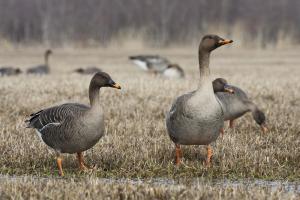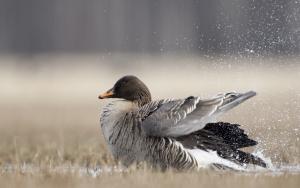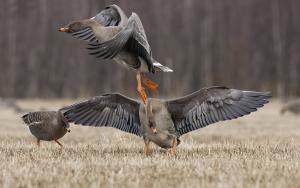Taiga Bean Goose
Taiga Bean Goose
The Taiga Bean Goose is one of the few declining goose populations in the Western Palearctic; the wintering population size, estimated at 100,000 birds in the mid-1990s, had decreased to 63,000 by 2009. Taiga Bean Geese breed discontinuously in the boreal zone from Fennoscandia to Western Siberia and winter in north-west Europe and Central Asia.
The Bean Goose is globally categorized as a species of Least Concern (LC) according to the IUCN Red List. This is because the IUCN makes no distinction between the subspecies Tundra Bean Goose (Anser fabalis rossicus), which is considered to have a stable population, and Taiga Bean Goose (Anser fabalis fabalis).
Under AEWA, however, a distinction is made between the subspecies. An International Single Species Action Plan (ISSAP) that covers the entire Bean Goose subspecies Anser fabalis fabalis, which is confined to the Western Palearctic and western parts of the Eastern Palearctic, was launched in 2015. This is the first flyway conservation plan under the Agreement for a species in decline which is still open for hunting.
Four sub-populations can be recognised based on their different breeding and wintering areas, which serve as basis for the Management Units of this Action Plan:
- The Western Management Unit comprises birds that breed in the central part of Scandinavia and winter almost exclusively in the United Kingdom and northern Denmark. A small number of birds may also winter in Norway and Sweden.
- The Central Management Unit encompasses Taiga Bean Goose breeding areas in northernmost Sweden, northern and central Finland, north-east Norway and the Russian Federation. These populations winter in Denmark, Germany, the Netherlands and southern Sweden.
- Eastern 1 Management Unit birds breed in the Russian Federation. They migrate through Belarus, Estonia, Latvia, Lithuania and Ukraine on their way to their wintering regions in Germany, the Netherlands, Poland and, in small numbers, southern Sweden.
- Very little is known about the Taiga Bean Goose of the Eastern 2 Management Unit. Their primary breeding region is thought to be in the eastern parts of the lowlands of Western Siberia, and they winter in Kazakhstan, Kyrgyzstan and north-west China.
Knowledge of the specific processes and factors affecting the change in population size of the Taiga Bean Goose is scarce or lacking and the exact causes for the population decline are thus largely unknown. However, both legal and illegal harvesting are considered to significantly affect both adult survival and reproductive rates. The loss, fragmentation and degradation of suitable habitat due to forestry, infrastructure development and other human-related factors are also considered significant threats to Taiga Bean Geese.







